1. Objective
Build Transit Network in Azure, GCP and AWS using Aviatrix Multicloud Transit hub and spoke model.
In this lab, we will use Aviatrix CoPilot to connect three major clouds, i.e. Azure, GCP and AWS. The workloads in VPCs/VNets in all three clouds must communicate without manual configuration on the native consoles.
2. Multicloud Connectivity Overview
Enterprises are relying increasingly on multiple clouds (multicloud) providers. However, setting up the connectivity between those providers is difficult. Moreover, maintaining and monitoring the tunnels is time-consuming and cumbersome to troubleshoot.
Aviatrix simplifies this by providing simple, point-and-click tunnel creation between cloud providers.
Additionally, Aviatrix gives you a single, centralised location from which to troubleshoot and monitor your connections.
3. Topology
In this lab, as shown in the topology below, we will configure the grey Aviatrix gateways, the grey attachments between Transit-Spoke and the grey peerings betweenTransit-Transit, but only in the following regions:
- AWS: us-east-2
- GCP: us-central-1
- AZURE: us-west (only spoke1)
The rest of the topology has been pre-deployed to save time, including the test instances/VMs.
NOTE: The test VPCs/VNet you created in Lab 1 will not be used in other labs.
In this lab, the Transits will be deployed in pairs, but the Spokes will not.
The CoPilot dashboard should look something like this: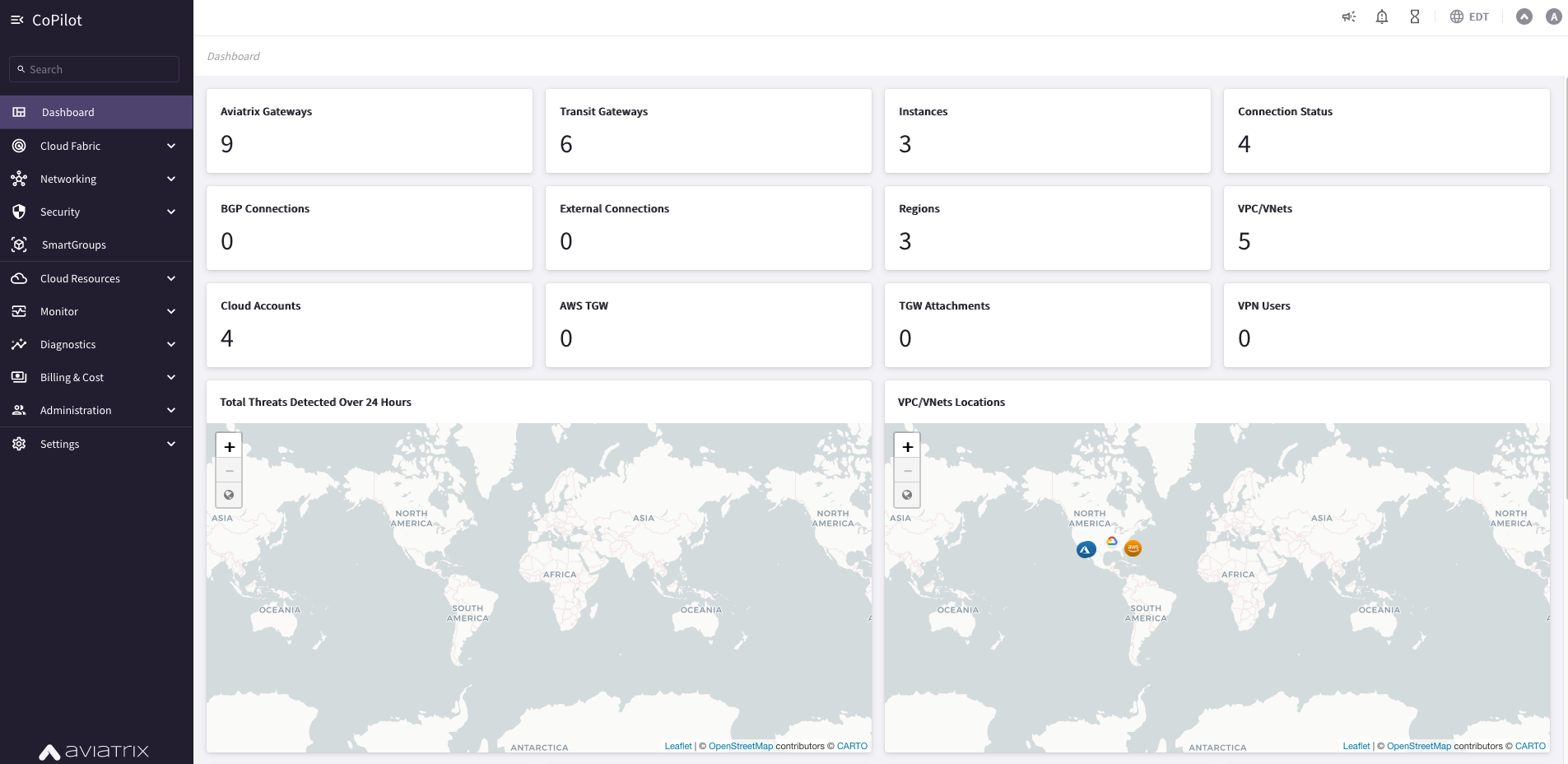
Go to CoPilot > Settings > Resources > Task Server
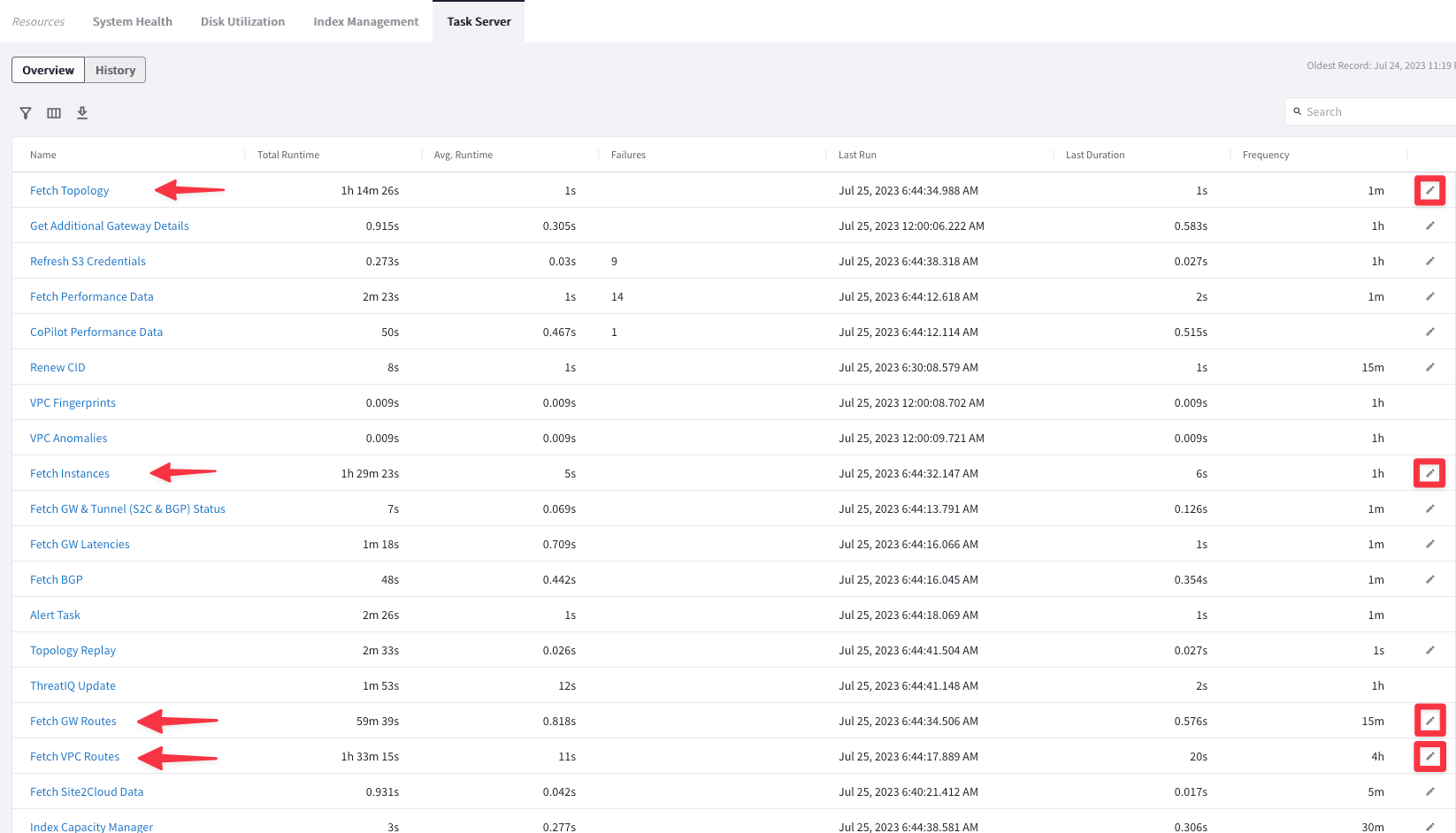
Ensure that Fetch Topology, Fetch Instances, Fetch GW Routes and Fetch VPC Routes intervals are set to “1 Second” each and then click on SAVE.
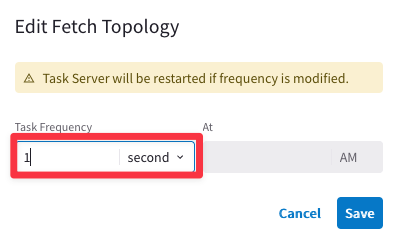
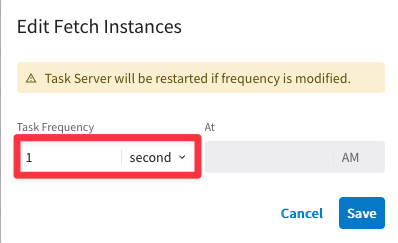
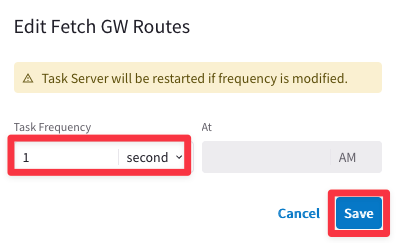

Afterwards, click on Commit.
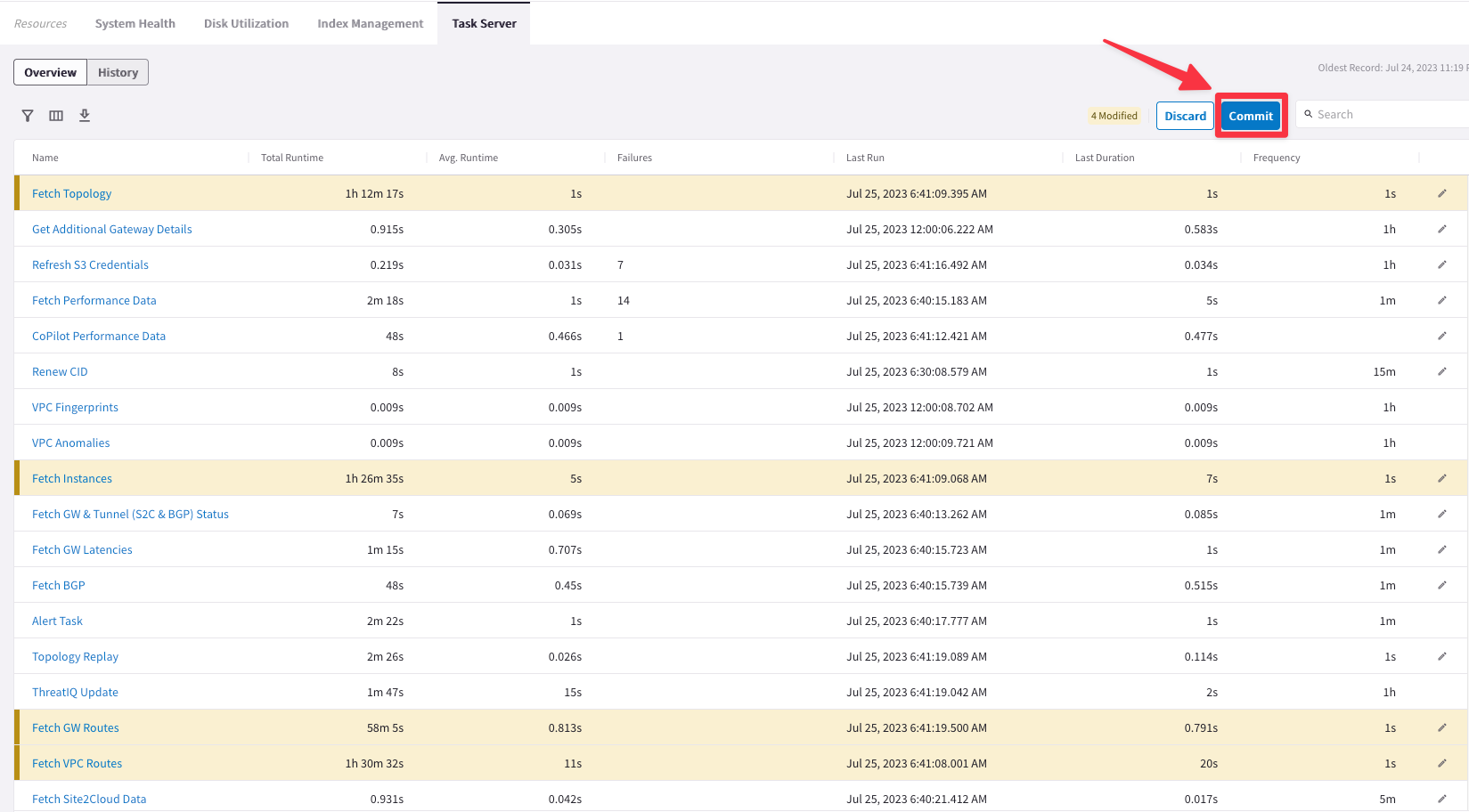
TIP: Ensure to Refresh the web page to see the changes applied, successfully.
Note: These are very aggressive settings. In a Production environment, you should not set these intervals that frequently!
4. Initial Configuration
Go to CoPilot > Dashboard and click on the widget called "Aviatrix Gateways". When you begin this lab, you should have nine gateways in your pod:
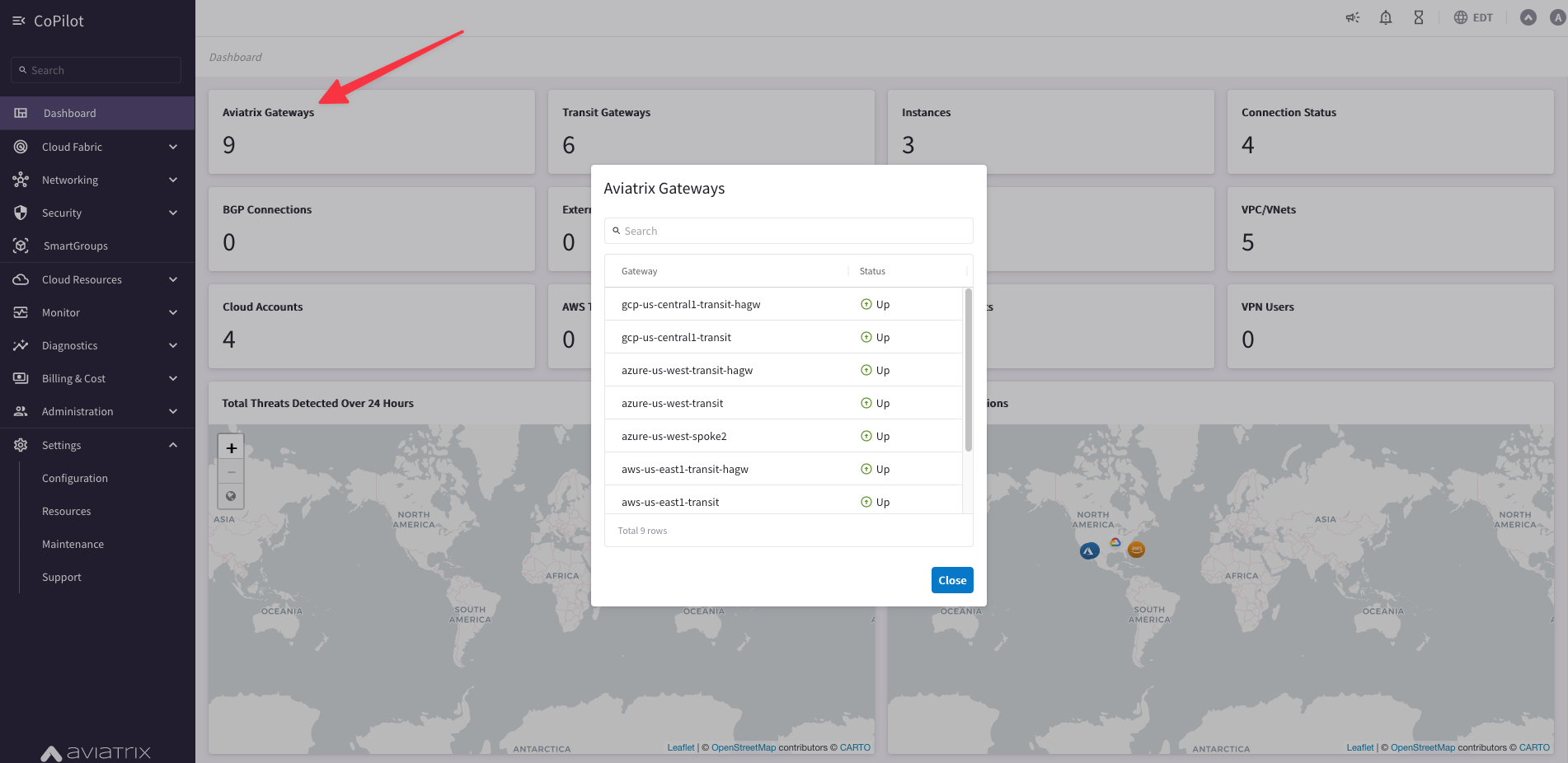
Nevertheless, if you go to CoPilot > Cloud Fabric > Gateways > Overview (default tab), you will notice that the number of Transit Gateways is set to three, whereas the number of Spoke Gateways is set to two:

This view within the Cloud Fabric section does not indicate the exact number of gateways but it refers to to the number of clusters, per each type of gateway.
Go to CoPilot > Cloud Fabric > Gateways > Transit Gateways and expand the three drop-down lists. You can find out that there are a total of six Transit Gateways (Public IPs may differ):
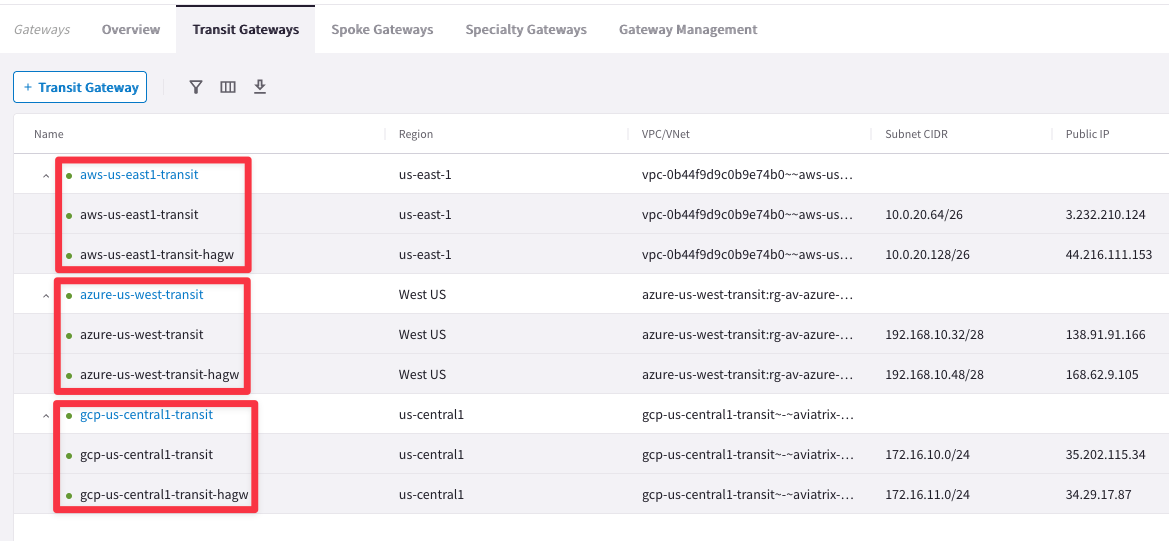
Furthermore, you can notice that the name of the cluster matches exactly the name of the first Transit Gateway, whereas the name of the second Transit Gateway is similar to the name of the first gateway but it has appended a "-hagw"; this is imposed by the "aviatrix_transit_gateway" Terraform resource.
Note: you can deploy up to maximum two Transit Gateways per each Transit VPC/VNet/VCN.
Go to CoPilot > Cloud Fabric > Gateways > Spoke Gateways and expand the unique drop-down list. You can find out that there are a total of three Spoke Gateways (once again, the Public IPs may differ):

You can notice that the cluster in AWS comprises two Spoke Gateways, whereas in Azure there is just a single Spoke Gateway. This is a valid deployment. The number of Spoke Gateways that you should deploy per each Spoke VPC/VNet/VCN is dictated by your architecture design.
Note: you can deploy up to maximum fifteen Spoke Gateways per each Spoke VPC/VNet/VCN.
4.1. Aviatrix Transit Gateways
In this section, you will experience the power and simplicity of the Aviatrix platform by deploying (i.e. creating) 5 gateways:
- First Transit gateway in AWS US East 2: aws-us-east2-transit
- Second Transit gateway in AWS US East 2: aws-us-east2-transit-1
- Spoke gateway in AWS US East 2: aws-us-east2-spoke1
- Spoke gateway in Azure West US: azure-us-west-spoke1
- Spoke gateway in GCP US Central 1: gcp-us-central1-spoke1
Please pay close attention to each step, as a misconfiguration could result in 20+ minutes of lost time!
Go to CoPilot > Cloud Fabric > Gateways > Transit Gateways > + Transit Gateway

Deploy Aviatrix Transit Gateways in AWS east-2 region. To save time, Aviatrix Transit Gateways in Azure, GCP and AWS east-1 region have already been pre-deployed in pairs for this lab.
4.1.1.Transit Gateways in AWS east-2
Ensure these parameters are entered in the pop-up window "Create Transit Gateway".
- Name: aws-us-east2-transit
- Cloud: AWS (Standard)
- Account: aws-account
- Region: us-east-2 (Ohio)
- VPC ID: aws-us-east2-transit (Make sure you don't select aws-us-east2-spoke VPC)
- Instance Size: c5n.large
- High Performance Encryption: On
Click on + Instance (Make sure you deploy also the Second Transit Gateway, in a different subnet).
- Attach to Subnet (row 1): us-east-2a
- Attach to Subnet (row 2): us-east-2b
- Public IP: Allocate New Static Public IP
Note: as soon as you select High Performance Encryption, /26 subnets will appear in the drop-down window.
Click SAVE.
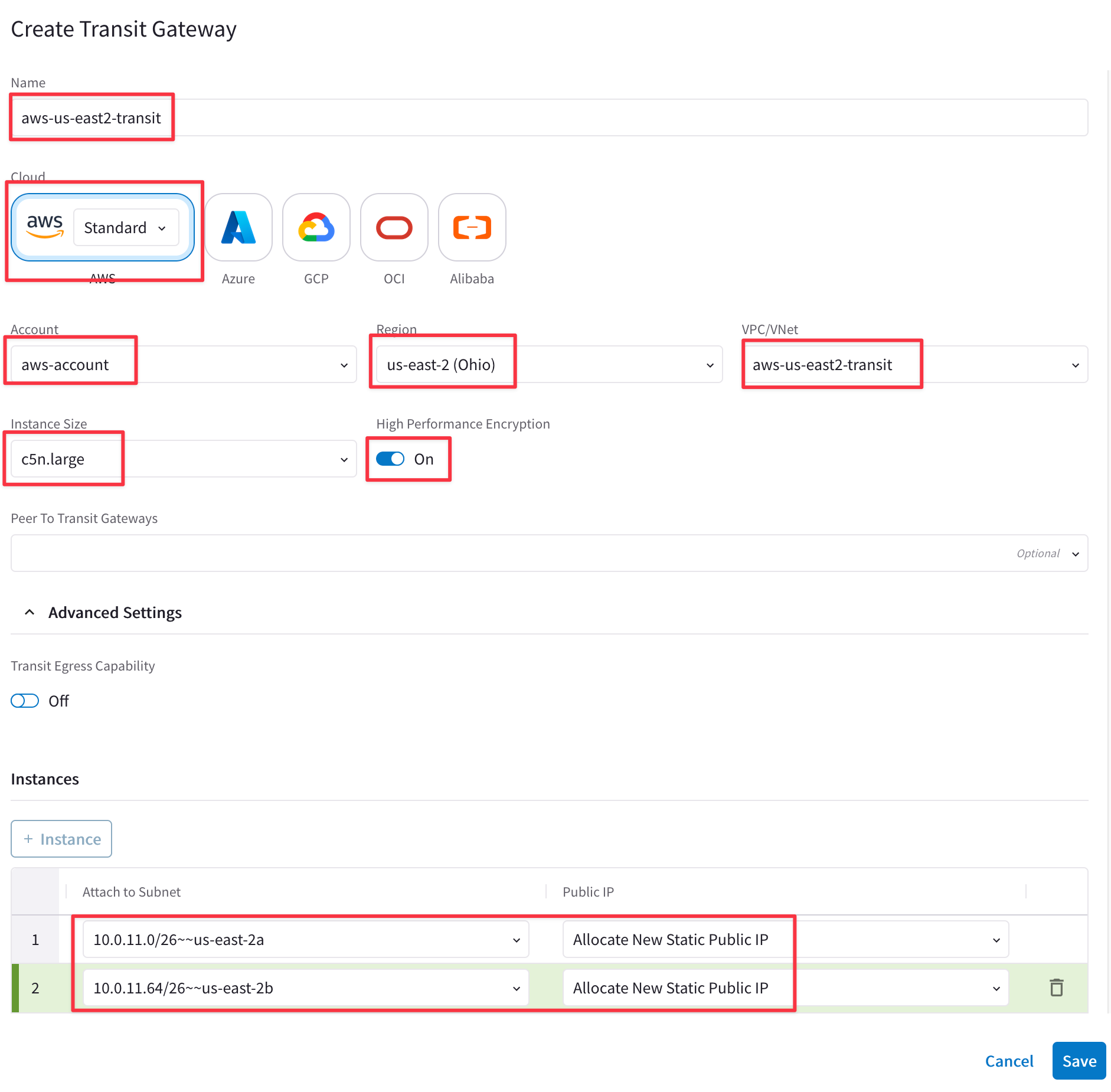
You will immediately get a message as follows.

You may check the status of the gateway creation in the top right corner by expanding the task icon.
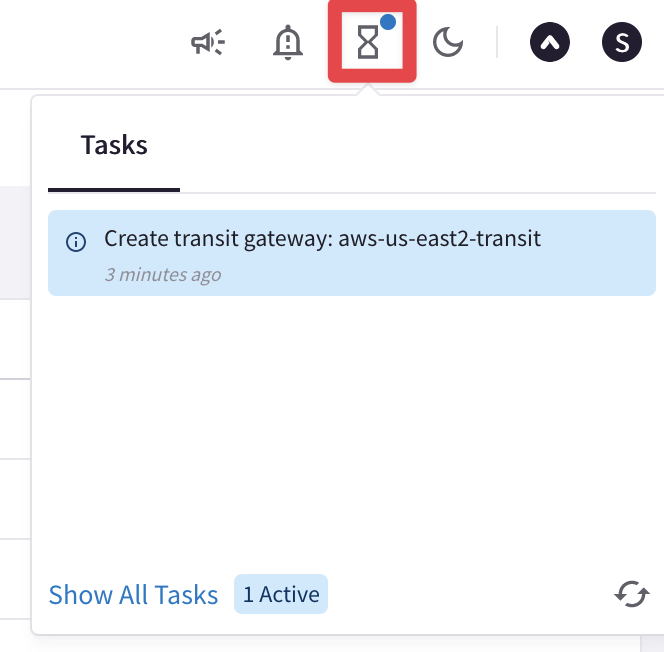
This action will instantiate two Transit Gateways with the following names:
- aws-us-east2-transit
- aws-us-east2-transit-1
Note: The second gateway will receive "-1" appended to its name, in order to differentiate it from the first gateway.
Meanwhile the deployment is happening, you may proceed to the next section of this lab guide to deploy your Spoke gateways.
4.2. Aviatrix Spoke Gateways
Navigate to the tab immediately to the right, which is Spoke Gateways.
This is CoPilot > Cloud Fabric > Gateways > Spoke Gateways > + Spoke Gateway

4.2.1. Spoke Gateway in AWS
Ensure these parameters are entered in the pop-up window "Create Spoke Gateway".
Note: only one Spoke Gateway will be deployed in VPC aws-us-east2-spoke1.
- Name: aws-us-east2-spoke1
- Cloud: AWS (Standard)
- Account: aws-account
- Region: us-east-2 (Ohio)
- VPC ID: aws-us-east2-spoke1 (Make sure you don't select aws-us-east2-transit VPC)
- Instance Size: t2.micro
- High Performance Encryption: Off
- Attach to Subnet: us-east-2a
- Public IP: Allocate New Static Public IP
Click SAVE.
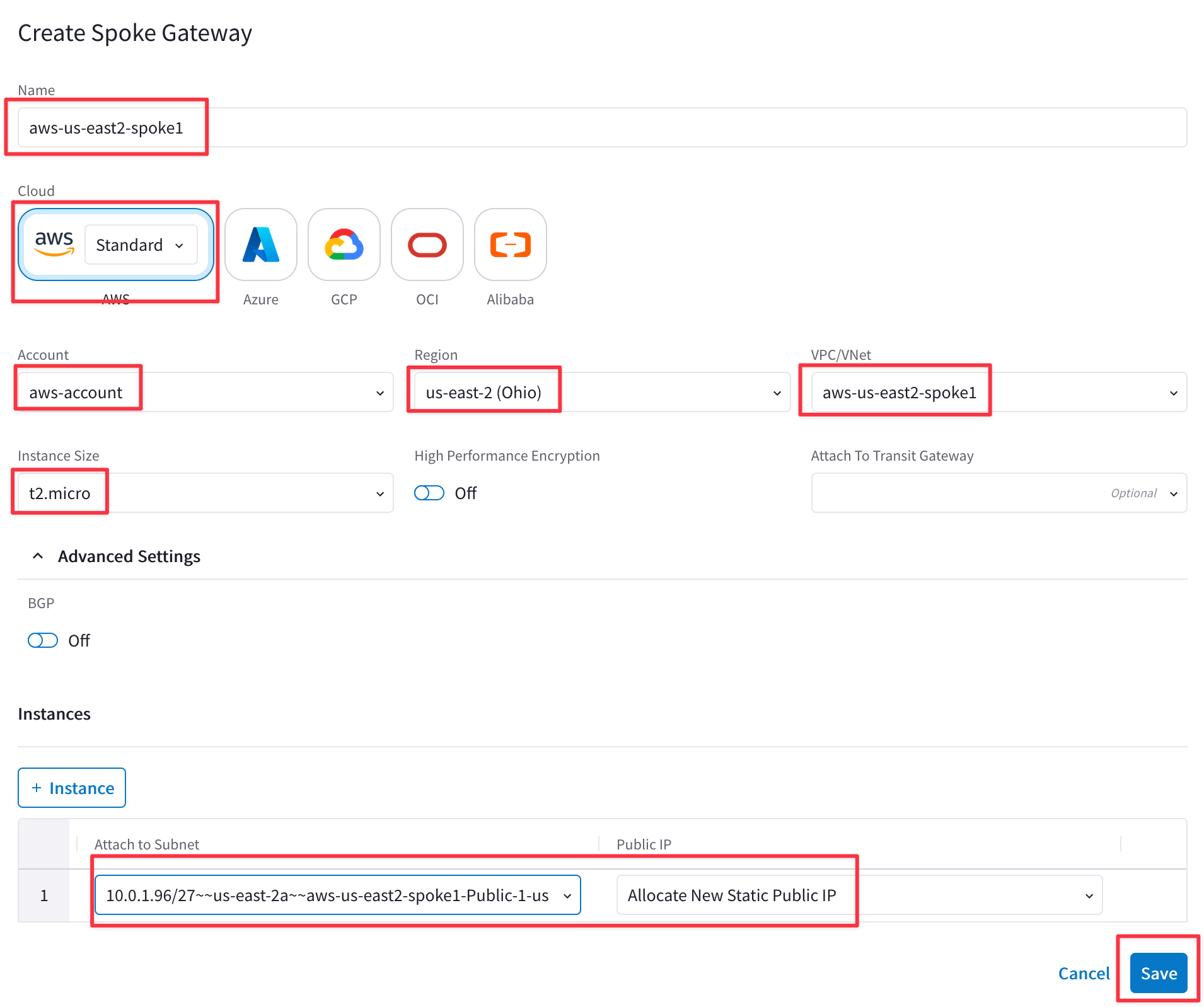
While the gateway is being created, you may proceed to the next section.
4.2.2. Spoke Gateway in Azure
Repeat the previous steps for Azure, click on the button "+ Spoke Gateway" and ensure these parameters are entered in the pop-up window "Create Spoke Gateway".
Note: only one Spoke Gateway will be deployed in VNet azure-us-wes-spoke1.
- Name: azure-us-west-spoke1
- Cloud: Azure (Global)
- Account: azure-account
- Region: West US
- VNet: azure-us-west-spoke1 (Make sure you don't select azure-us-west-spoke2 VPC)
- Instance Size: Standard_B1ms
- High Performance Encryption: Off
- Attach to Subnet: azure-us-west-spoke1-Public-gateway-subnet-1
- Public IP: Allocate New Static Public IP
Note: Make sure you do not select the subnets that begins with az-1, az-2, or az-3. It is Aviatrix's recommended practice to deploy gateways in subnets with 'gateway' in their name and workloads in subnets that do not have 'gateway' in their name).
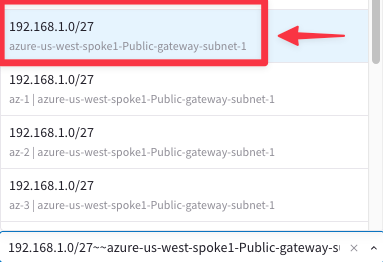
Click on SAVE.
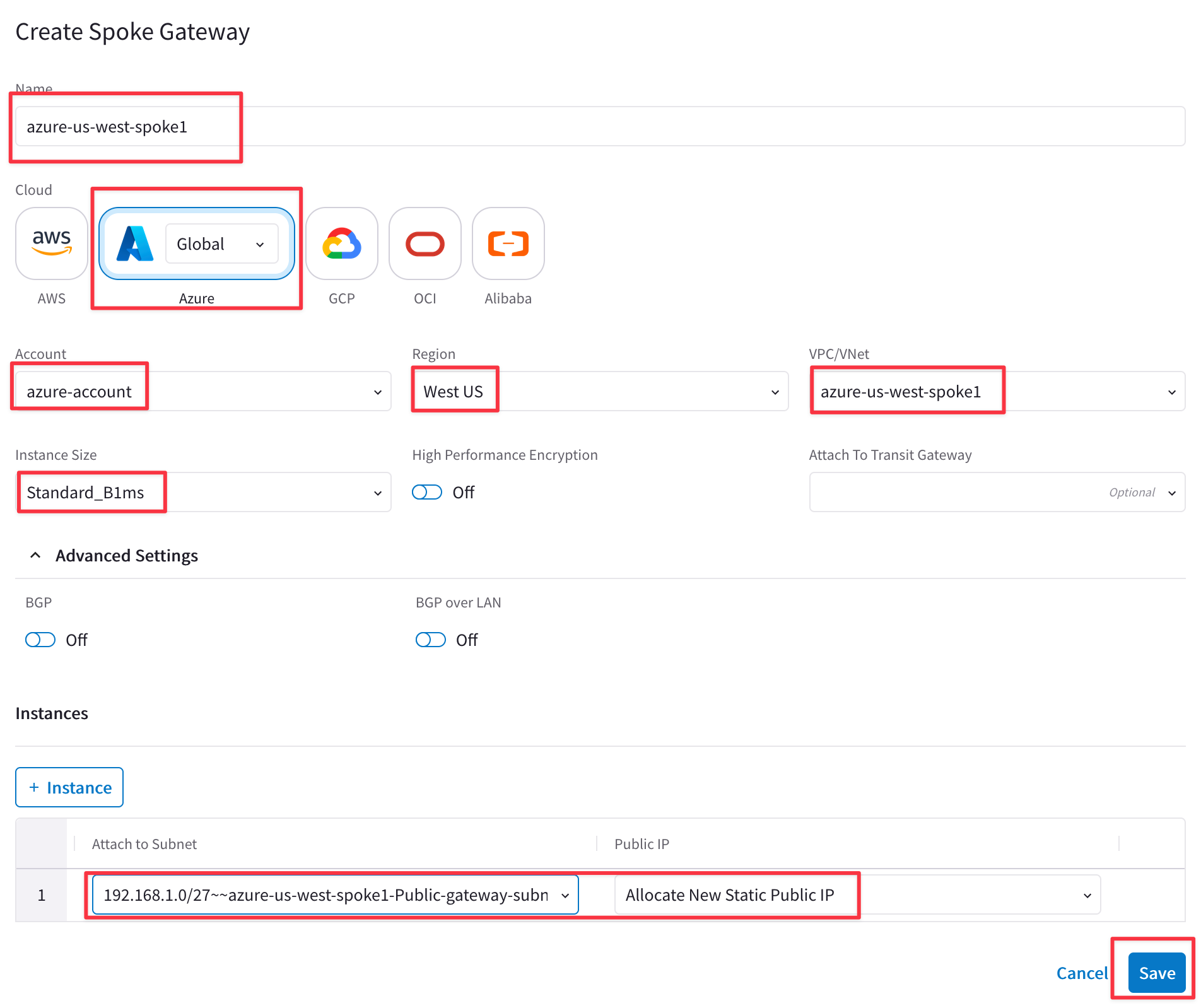
While the gateway is being created, you may proceed to the next section.
4.2.3. Spoke Gateway in GCP
Repeat the previous steps for GCP. Ensure these parameters are entered in the pop-up window "Create Spoke Gateway".
Note: only one Spoke Gateway will be deployed in VPC gcp-us-central1-spoke1.
- Name: gcp-us-central1-spoke1
- Cloud: GCP
- Account: gcp-account
- VPC: gcp-us-central1-spoke1
- Instance Size: n1-standard-1
- High Performance Encryption: Off
- Attach to Subnet: gcp-us-central1-spoke1-sub1
- Zone: us-central1-a
- Public IP: Allocate New Static Public IP
Click SAVE.

Remember: You can see the progress of gateway deployment at any time by expanding the task icon in the top right corner of the CoPilot.

Once all gateways have been created, confirm from CoPilot > Dashboard that 14 gateways exist in your environment:
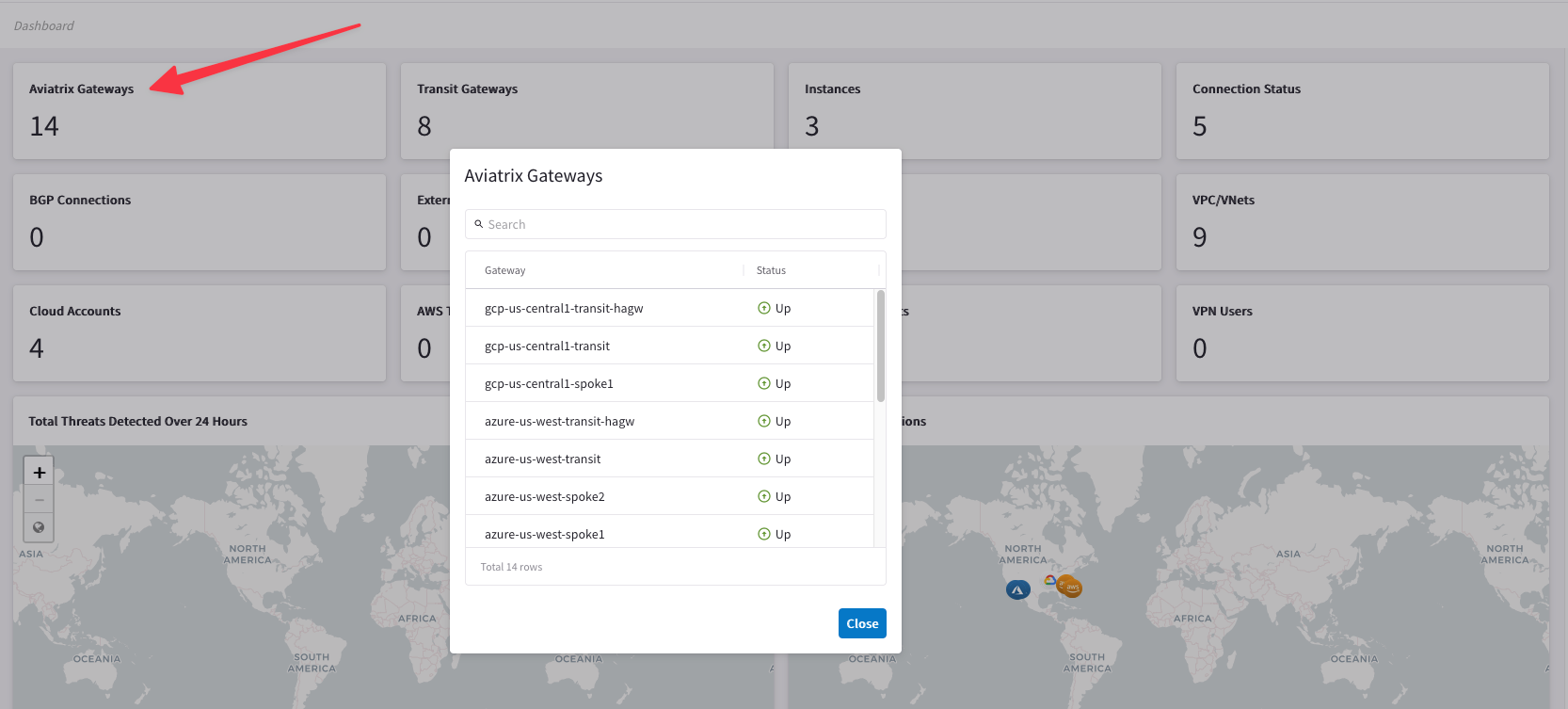
After creating the Transit gateways pair in AWS and the Spoke gateways in each cloud, this is how a portion of the topology would look like.
4.3. Explore the AirSpace
Go to CoPilot > Cloud Fabric > Topology > Overview (default tab).
Expand the Topology to see it in its entirety.
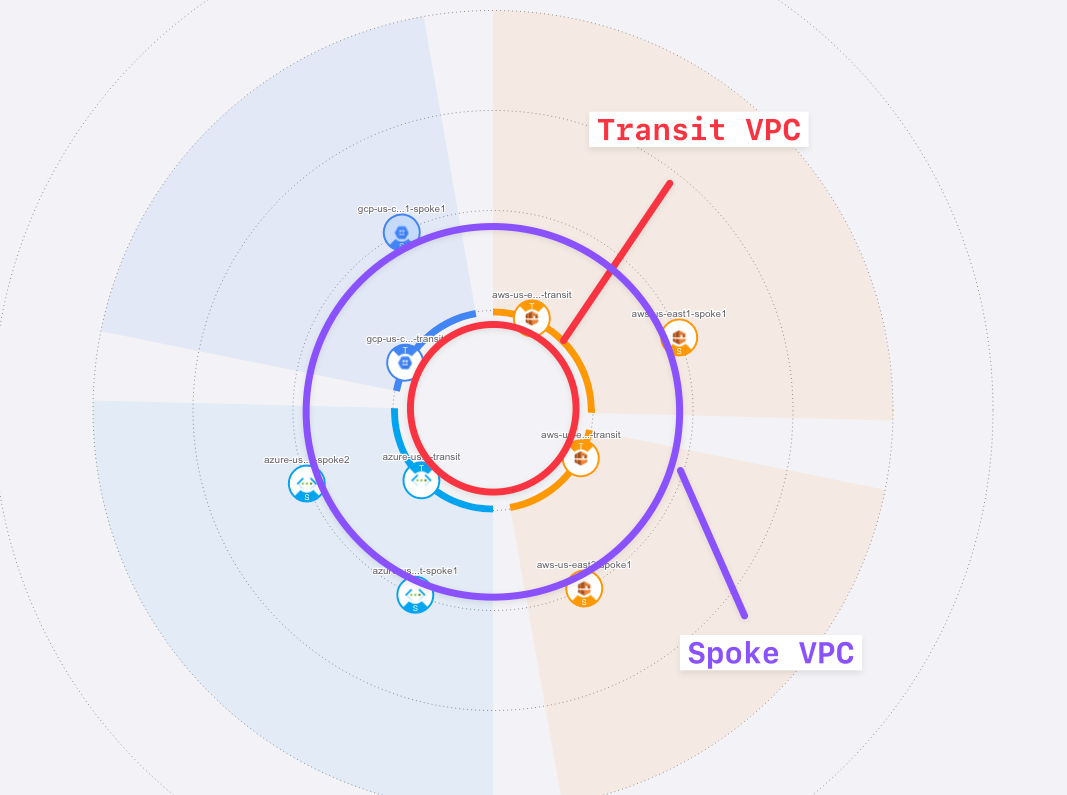
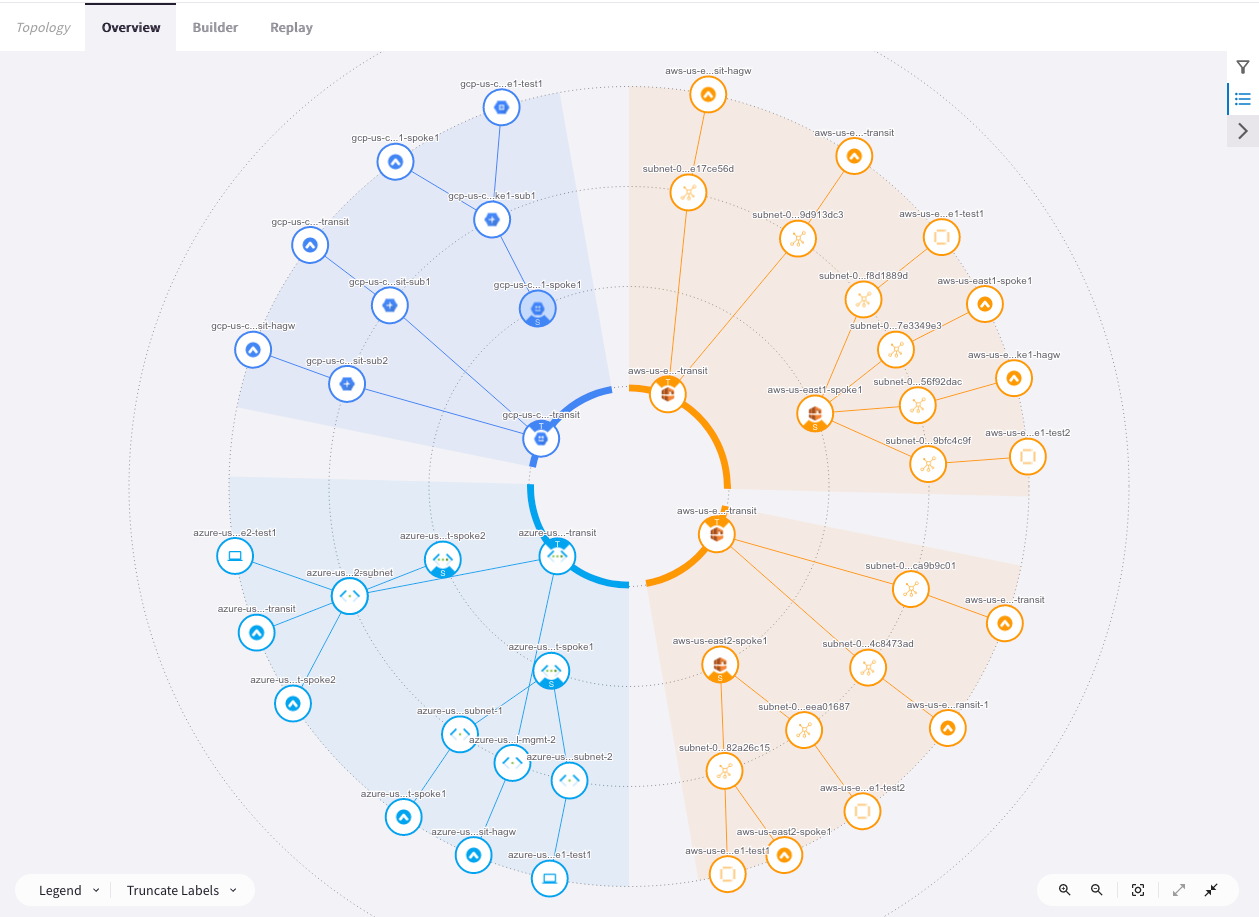
The inner circle represents the Transit Gateway VPCs, and the outer one represents the Spoke Gateway VPCs.
It is clearly shown at this stage that the spokes are not connected to the transits.
In addition, you can explore the components of any of the gateways in terms of subnets and Virtual Machines that reside within the VPC/VNet.
4.4 Aviatrix Spoke to Transit Gateways Attachment
In this section you are going to attach the Aviatrix Spoke Gateways created above in each cloud, to their corresponding Aviatrix Transit Gateways.
4.4.1. Spoke to Transit Attachment in AWS
Go to CoPilot > Cloud Fabric > Gateways > Spoke Gateways and edit the Spoke Gateway aws-us-east2-spoke1, clicking on the pencil icon:

Select the Transit Gateway aws-us-east2-transit from the drop-down window from the "Attach To Transit Gateway" field, and then click on Save.

You will see immediately a message informing that the updating is in progress.

4.4.2 Spoke to Transit Attachment in Azure
- azure-us-west-spoke1 to azure-us-west-transit
Edit the Spoke Gateway azure-us-west-spoke1 (not the spoke2), clicking on the pencil icon.

Select the Transit Gateway azure-us-west-transit from the drop-down window from the "Attach To Transit Gateway" field, and then click on Save.

4.4.3. Spoke to Transit Attachment in GCP
- gcp-us-central1-spoke1 to gcp-us-central1-transit
Edit the Spoke Gateway gcp-us-central-spoke1, clicking on the pencil icon:

Select the Transit Gateway gcp-us-central1-transit from the drop-down window from the "Attach To Transit Gateway" field, and then click on Save.
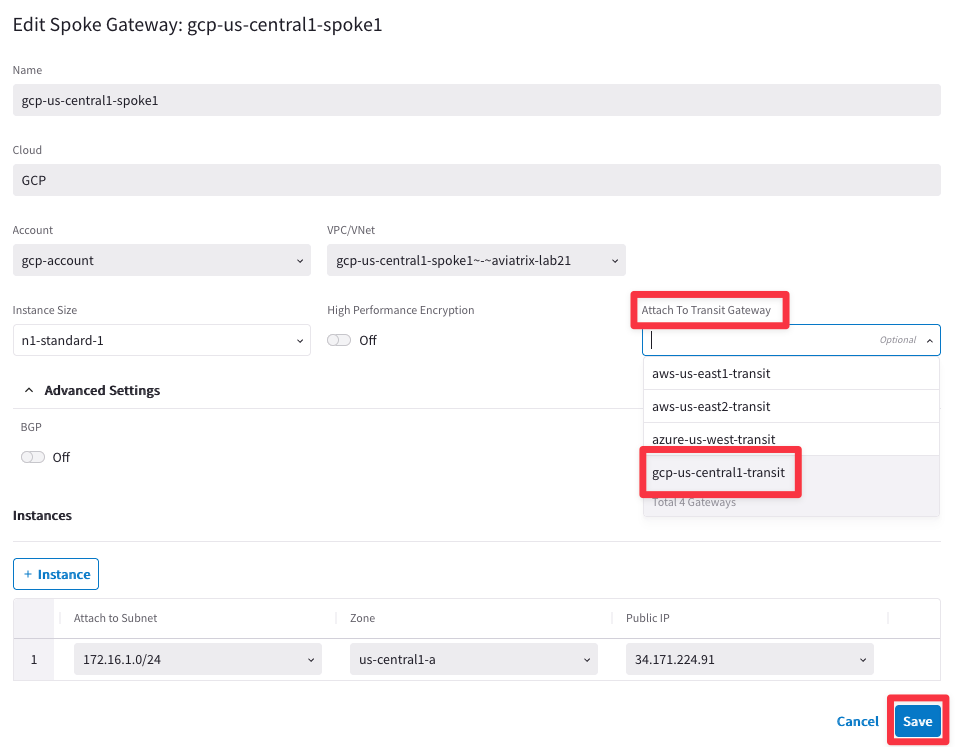
Look for these three confirmations through the task icon, before proceeding.

At this point, after attaching Spoke Gateways to their respective Transit Gateways, this is what the overall topology would look like.
Note: The Spoke Gateway azure-us-west-spoke2 will be attached to its Transit Gateways in a subsequent lab, likewise the Spoke Gateways in AWS us-east-1 will be attached to the Transit Gateways in the same region only in a subsequent lab.
4.5. CoPilot Verification of Spoke-Transit Attachments
Go to CoPilot > Cloud Fabric > Topology > Overview
Now, verify the spoke-transit attachments. You can see the dotted lines connecting the 3 spoke gateways to their respective transits.
Tip: Be patient, it will take some minutes before seeing the changes reflected into the topology. Refresh the page to see the change reflected on the map!
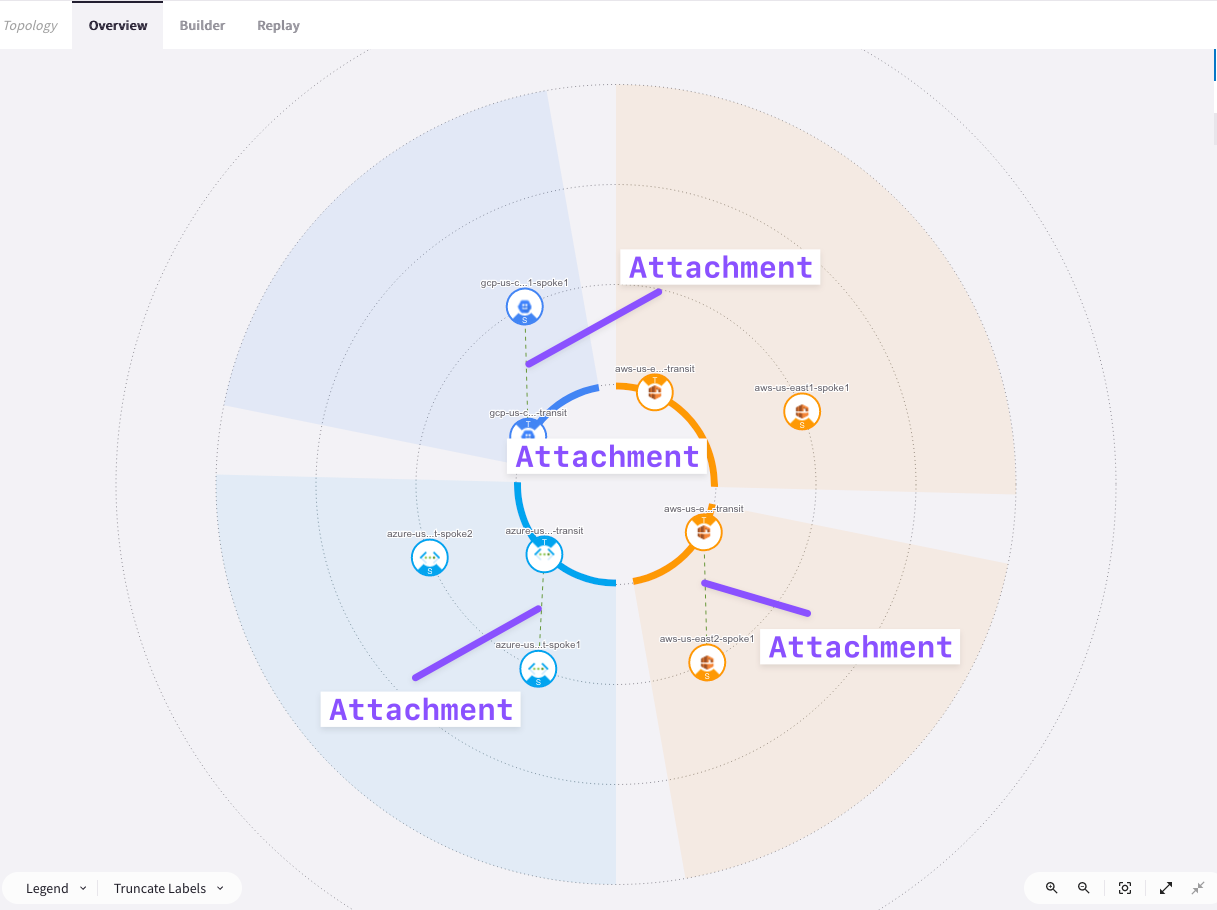
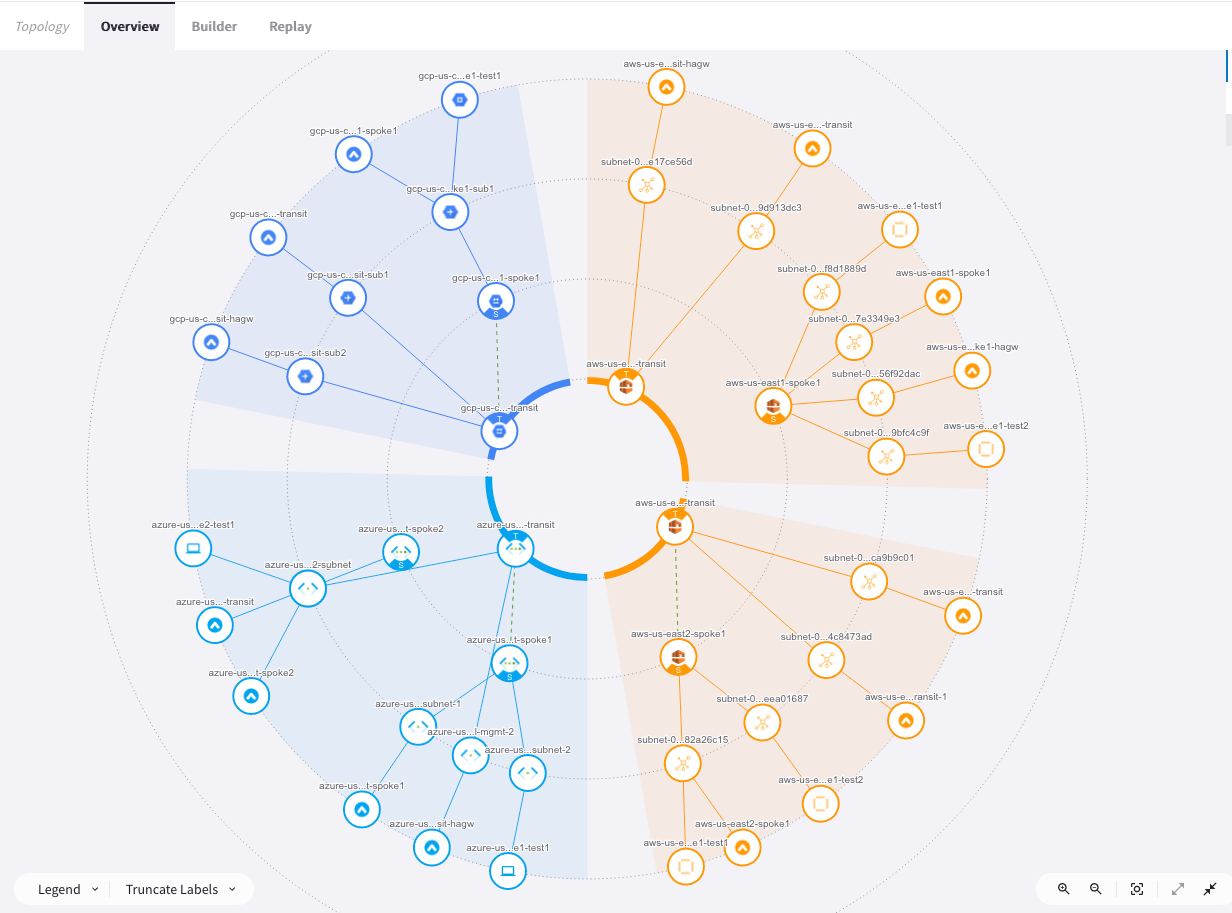
4.6. Multicloud Transit Peering
In this section you are going to establish the peerings among the Aviatrix Transit Gateways.
Note: Transit peering is bi-directional. You do not need to configure peering in the opposite direction.
Go back to CoPilot > Cloud Fabric > Gateways > Transit Gateways
4.6.1. AWS and Azure
- aws-us-east2-transit to azure-us-west-transit
Edit the Transit Gateway aws-us-east2-transit, clicking on the pencil icon:

Select the Transit Gateway azure-us-west-transit from the drop-down window from the "Peer To Transit Gateways" field, and then click on Save.
 192.
192.
4.6.2 Azure and GCP
- azure-us-west-transit to gcp-us-central1-transit
Edit the Transit Gateway azure-us-west-transit, clicking on the pencil icon:

Select the Transit Gateway gcp-us-central1-transit from the drop-down window from the "Peer To Transit Gateways" field, and then click on Save.

4.6.3. GCP and AWS
- gcp-us-central1-transit-agw to aws-us-east2-transit
Edit the Transit Gateway gcp-us-central1-transit, clicking on the pencil icon:

Select the Transit Gateway aws-us-east2-transit (not the east1 !) from the drop-down window from the "Peer To Transit Gateways" field, and then click on Save.

At this point, this is what the overall topology would look like:
Note: Please pay close attention that the following pending elements will be completed only in a subsequent lab:
- Attachment between aws-us-east1-spoke1 and aws-us-east1-transit
- Peering between aws-us-east1-transit and aws-us-east2-transit
- Attachment between azure-us-west-spoke2 and azure-us-west-transit
5. Verification
5.1. Verification of Transit Peering on CoPilot (AirSpace)
Go to CoPilot > Cloud Fabric > Gateways > Transit Gateways, select the Transit Gateway aws-us-east2-transit, then select the "Connections" tab and finally select the "Transit-Transit Peering" sub-tab:

5.2. Verification of Transit Peering on CoPilot (Topology)
Go to CoPilot > Cloud Fabric > Topology > Overview
TIP: refresh the page!
Verify transit-transit peering. You can now see the dotted lines in the inner circle representing the configured full mesh peering between the three transits.

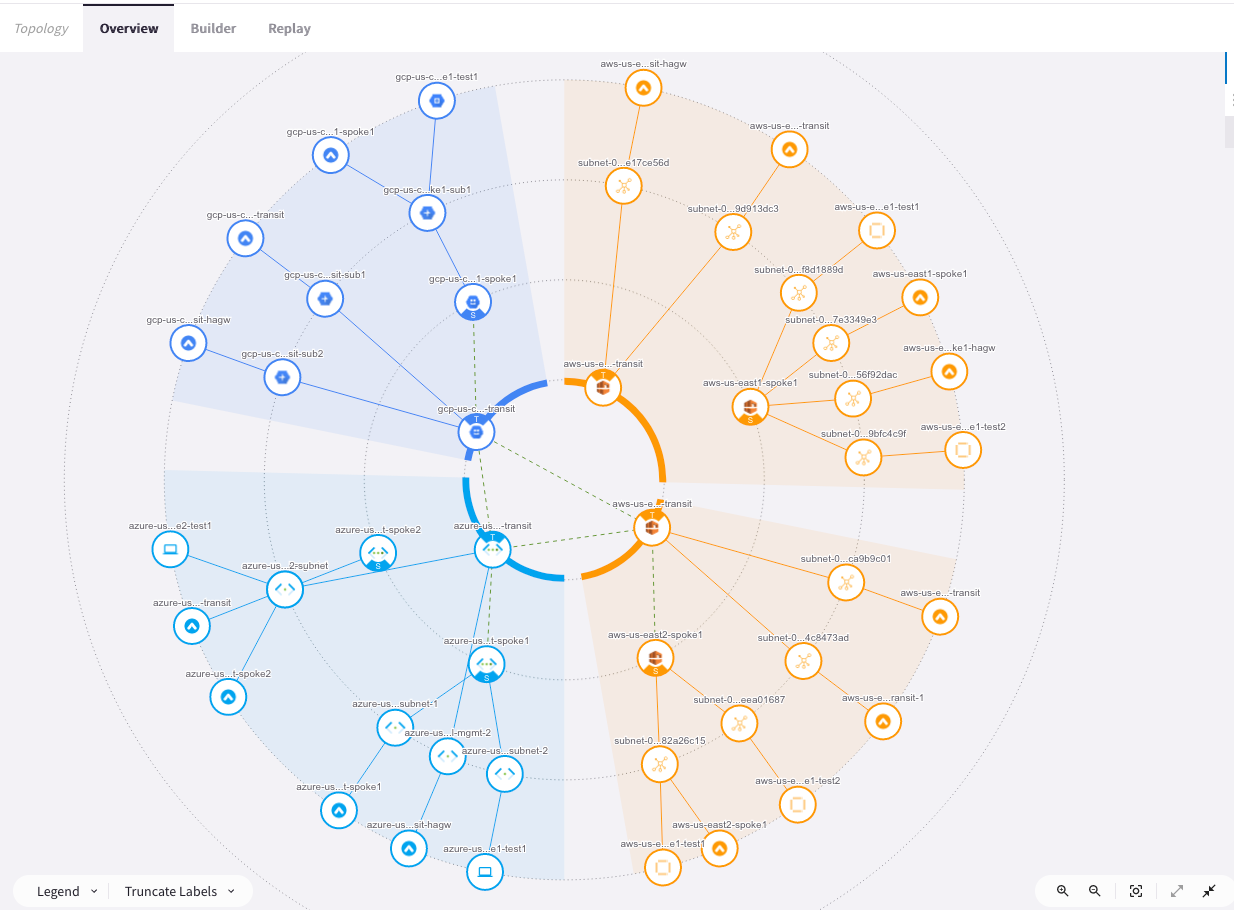
5.3. Route Info DB
Route Info DB is similar to Routing Information Base (RIB). It will provide the overall routing information of a Transit Gateway known by the CoPilot
Go to CoPilot > Cloud Fabric > Gateways > Transit Gateways and select the Transit Gateway aws-us-east2-transit:

Then select the "Route DB" tab. Pay special attention to “Best Routes”, its prefixes, type and metric value:

5.4. Connectivity
Verify each test instance can ping each other.
Open three terminal windows to SSH to the public IPs of the 3 spoke test instances/VMs in each cloud.
Then ping the private IPs of each other to test the Multi-Cloud connectivity. Refer to your pod portal for the private IPs or retrieve the private IPs from the topology.
- SSH into aws-us-east2-spoke1-test1 (ssh student@public_ip)
- SSH into azure-us-west-spoke1-test1 (ssh student@public_ip)
- SSH into gcp-us-central1-spoke1-test1 (ssh student@public_ip)
Run ping from the AWS instance to verify connectivity to Azure and GCP:

Run ping from Azure VM to verify connectivity to AWS and GCP:

Run ping from GCP VM to verify connectivity to Azure and AWS:

6. Bonus Questions
- What resources are created in the respective clouds when deploying the transit gateway?
